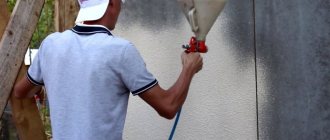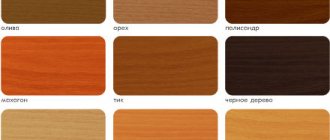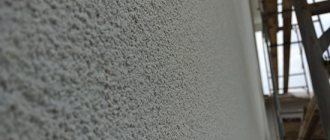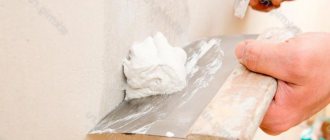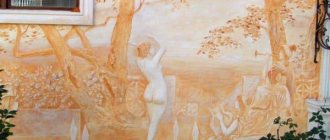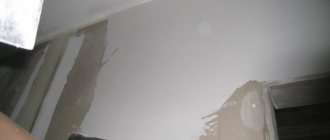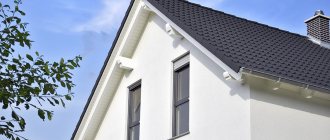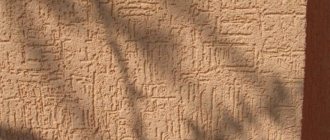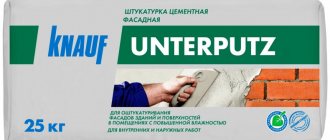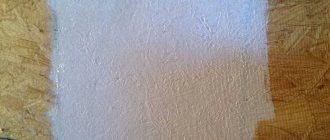The final design of the facades involves the use of special materials. To level the surface of the walls and seal cracks, putty is used, which is a dry mixture. It is applied to a wall treated with a deep penetration primer and is resistant to cracking. What types of finishing mixture are there? What are their advantages and disadvantages? Is it possible to make cement-based putty yourself? We will try to answer all questions in detail.
Types of putty
Putty is a thick mass consisting of binding elements that, after hardening, form a durable surface. The main purpose of façade putty is to level out defects and fill small voids to create a smooth surface.
The putty is sold in the form of a dry and ready-mixed mixture. The disadvantage of the ready-made putty mixture is its limited shelf life and rapid hardening.
Depending on the purpose, putty is made from various materials:
- Cement based;
- Gypsum based;
- Acrylic;
- Latex;
- Oil glue.
When plastering, the following types of facade putty are used:
- Mineral;
- Acrylic;
- Silicate;
- Silicone.
Waterproof facade putty - designed to create a protective and decorative layer. Materials for the exterior decoration of buildings must have a certain list of properties.
Putty makes the surface strong, durable, resistant to seasonal temperature changes and precipitation.
An important role is played by a high level of adhesion, that is, the ability to stick to any material. Compatibility with any paint and varnish materials is a prerequisite when choosing a putty.
Due to the large surface area to be treated, preference is given to dry mixtures, which are mixed with water until the finished mass is obtained. According to reviews, cement-based façade putty is popular.
Peculiarities
Facade putty can be used on brick or concrete.
By putting putty on these surfaces, you can level them and protect them from adverse natural factors. When performing any external work, one cannot do without chips, chipped corners of bricks and other things, and in order to hide all these flaws, putty is used. Due to the different conditions for which putty is selected, its types also differ. Frost-resistant is characterized by maximum surface protection even in very severe frosts. If you putty the wall correctly, then for a long time you will not need to correct any flaws caused by time. It is best to use waterproof plaster on top of such façade putty.
If you want your home to always be warm and cozy, it is important to correctly apply a layer of putty on the outside, which will ensure the desired effect. Facade putty will help give any external surface an ideal appearance so that decorative finishing can be done on top
How exactly to decorate the walls of a house or other building is a secondary issue; the main thing is to hide all the imperfections, insulate the walls and prepare them for further finishing.
The technical characteristics of facade plaster must be correctly selected for the type of work you are planning. Failure to comply with such nuances can result in wasted time and poor-quality repairs. When planning finishing with plaster, you need to know what layer thickness is most optimal for a particular surface. Most often it is determined by uneven places, focusing on convex points and depressions. The thinner the layer, the faster it will dry, but also the faster it will deform from external factors.
Cement-based putty
Cement putty for facades is an excellent option for treating the front surface of a house. It comes in the form of a dry mixture consisting of cement, sand and some binders. The cement contained in the putty gives the surface high strength and resistance to moisture.
One of the most popular in the construction environment is Knauf facade putty. There are two types of cement putties:
- Basic;
- Finish.
Basic façade putty is usually applied in a thick layer up to 1.5 cm and serves as a filler for large cracks and irregularities.
The finishing façade putty has a delicate composition and, after drying, creates a smooth and even surface. The use of cement putty for facade work should be carried out at a temperature not lower than +5 degrees and a humidity of 80%.
The finished mixture cannot be mixed with paints, glue or other substances; it may lose its properties, which means the quality of work will be low.
Both amateurs and professionals note that cement putty is one of the most popular finishing materials for facades in terms of price and quality of coating.
Video description
The video shows ideas that can be adopted by those who are trying to create texture using decorative plaster:
Final finishing
The putty itself is white. If you are not satisfied with it, the finished finish can be additionally painted with water-based paint. But to create an even shade, experts prefer to add colored pigments to the finished solution. When diluted, it will be a little darker; when it lies on the walls and dries, the color will become two shades lighter. This must be taken into account when choosing this coloring technology.
Its difficulty lies in the fact that you cannot immediately prepare the solution for decorating the walls: it sets quickly. And it is extremely difficult to create two identical shades when mixing again. Each time the color of the mixture will be new. Therefore, it is worth adding pigments to the putty only when surfaces of a small area are being treated. In other cases, it is easier to paint already finished surfaces, then the decorative putty walls will look the same color.
Painting is done with a brush or roller. Usually two layers of paint are applied: one base coat fills all the recesses, then, when it dries, a layer of contrasting composition or water-soluble paint two shades darker is applied. First, a small area is painted, then the applied layer is wiped off with a wet cloth without pressure. This technique helps to emphasize the relief and highlight its convex parts.
Decorative putty painted in two colors Source avatars.mds.yandex.net
Polymer putty
Polymer putties appeared in construction relatively recently. They are very convenient and can be stored diluted for up to 12 hours. Long-term freezing makes it very easy to use.
All polymer masses can be divided into two groups:
- Acrylic;
- Latex.
Acrylic putty
The surface of acrylic putty is highly durable and retains its properties even with large changes in temperature and humidity.
This material is very flexible and does not peel off.
- Apply a layer no more than 3 mm thick and only on the primed surface.
- A significant disadvantage of acrylic putty is its high cost, as well as its incompatibility with wood and metal surfaces.
- If there are deep irregularities, it is necessary to apply acrylic putty in several layers.
Latex putty
Supplied as a paste, ready to use. Depending on the purpose, there are two types: for leveling the surface and finishing. Suitable for application to any surface, including wood and metal. The prepared surface must be primed.
- Latex putty can be diluted with water, but not more than 1% by weight.
- You can only work at temperatures above +5 degrees.
- The mixture is resistant to temperature changes, the coating remains durable and does not deform.
A variety of colors will save on painting costs. The delicate composition of latex putty will give the wall an elegant look and the surface does not require additional treatment.
Preparation of putty
Each manufacturer provides detailed instructions on how to prepare the mixture for dry mixing. The proportions are indicated on the packaging.
Mixing the mass is carried out using a special mixing attachment on a drill.
- After kneading, the mixture should be left for 10-15 minutes and mixed thoroughly.
- You should not prepare a lot of solution at once; it may dry out and will not be homogeneous.
- The finished façade mass must be used within 20 minutes.
Homemade putty recipe
Facade putty for exterior use can be made with your own hands. Homemade putty is often used by experienced plasterers.
- You only need cement and sand mixed in a 1:4 ratio.
- The sand must be clean, sifted, without lumps of clay and stones.
- First mix the dry mixture and then add water. For light putty it is better to use white cement.
- This mixture is suitable for applying a base layer, and after drying it must be covered with a finishing layer.
Manufacturers
The best putty manufacturers offer high quality products. TOP 5 best façade putties according to the 2020 rating:
- Ctresit CT 29 - considered the best manufacturer of facade putty;
- Perel TeploRob - has a high level of thermal insulation;
- Dufa Struktur Putz - has the highest quality coating;
- EcoStone Bayramin - recognized as the best plaster with natural stone;
- Found TS117 - a mixture for mineral surfaces.
Moisture-resistant putties in Moscow
Moisture-resistant putties and other products can be purchased at Leroy Merlin in Moscow at low prices. Select the product you are interested in on the website and buy it in our online store. The range of products presented in the catalog is extremely wide. Among them there will certainly be a position suitable in all respects.
All products presented in the “Moisture-resistant Putties” section are produced by well-known companies that have proven themselves to be of high quality for their products.
You can always place an order and pay for it online on the official website of Leroy Merlin in Russia. For residents of the Moscow region, we not only have low prices for goods in the category “Moisture-resistant putties”, but also fast delivery to cities such as Moscow, Balashikha, Podolsk, Khimki, Korolev, Mytishchi, Lyubertsy, Krasnogorsk, Elektrostal, Kolomna, Odintsovo, Domodedovo , Serpukhov, Shchelkovo, Orekhovo-Zuevo, Ramenskoye, Dolgoprudny, Pushkino, Reutov, Sergiev Posad, Voskresensk, Lobnya, Ivanteevka, Dubna, Yegoryevsk, Chekhov, Dmitrov, Vidnoye, Stupino, Pavlovsky Posad, Naro-Fominsk, Fryazino, Lytkarino, Dzerzhinsky , Solnechnogorsk, Istra and Zhukovsky.
Tools
The most important tool when working with putty is a spatula. It is better to immediately buy a set of different sizes. If you need to putty a large area of the wall, then the spatula should be large, but for hard-to-reach places it is better to use a small one.
Rubber and silicone spatulas are very convenient to use and make it easier to level the surface.
Experienced professionals prefer durable spatulas made of carbon steel, which do not bend even when working with large masses of putty. It is more convenient to use a corner spatula for processing corners.
Tips for choosing
To choose the right putty mixture, you must adhere to the following recommendations:
- When choosing a putty, it is necessary to take into account the type of material that will subsequently be used when cladding the facade. For example, if he is going to paint, it is better to buy a ready-made mixture rather than a dry one.
- Before purchasing, the package with putty must be opened and carefully inspected. You should not buy products that have debris or hard lumps on the surface.
- When choosing a putty composition, you must carefully examine its characteristics. The mixture must be moisture and heat resistant so that it can be used outdoors.
